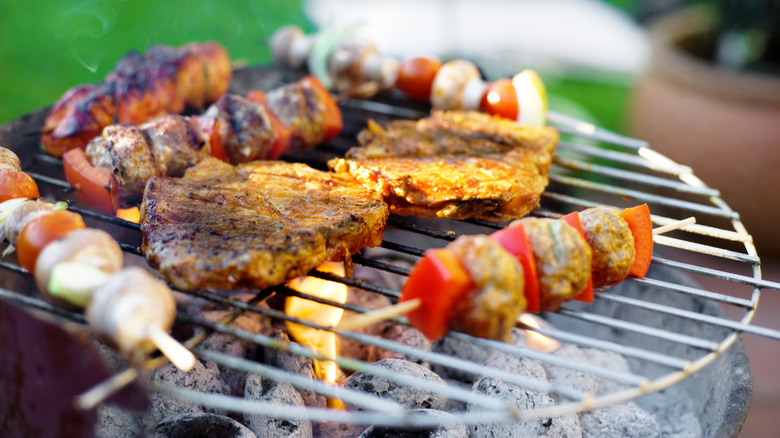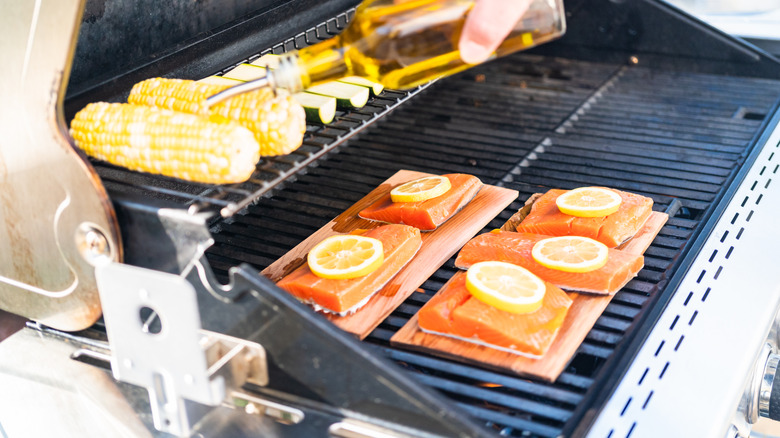Gas Or Charcoal Grill? Ina Garten Has A Clear Winner
When it comes to "hot issues" in the culinary world, one of the greatest topics to spark debate is whether a charcoal or gas grill produces better results. Food Network's Bobby Flay has stated his opinion on the subject, and his colleague Ina Garten also has a preference: she is team charcoal all day long. Fans have seen Garten stand over her 22.5 inch Weber grill several times on her TV show, "The Barefoot Contessa," as she perfectly cooks steaks, swordfish, lemon chicken, and corn on the cob. She even made breakfast on her grill during one episode.
Answering a fan's question on her website regarding the two types of grills, Garten writes, "I prefer a charcoal grill because I like the flavor, but if you prefer the ease of turning on a gas grill, that's perfectly fine, too!" It's true that setting up hot coals under a charcoal grill takes more time than switching on a gas flame, but for many grill enthusiasts, the smokier flavor is well worth it. As it turns out, that unmistakable flavor has less to do the charcoal itself and more to do with the heat and drippings from meat and other foods as they cook.
How a charcoal grill creates that smoky flavor
There are two types of charcoal that can be used for grilling (which shouldn't be confused with barbecuing): briquettes and lump charcoal. Briquettes are the pillow-shaped pieces you can find at most grocery stores. They are composed of leftover pieces of wood and sawdust that are compressed and sometimes treated with additives. Lump charcoal is made of real chunks of wood that have been slowly burned until all of the moisture and sap is released. Most agree that lump is superior to briquettes, partly because there are no additional chemicals to affect the taste.
While there are some grill buffs who swear that charcoal itself adds an amazing flavor to grilled foods, that smoky taste and caramelized exterior is actually the result of the high heat that charcoal produces. Lit charcoal produces tons of natural radiant heat, and when juice and fat from food drips onto the glowing coals, it transforms into steam and smoke, which is re-absorbed by the food. The coals' burning ability is what really makes the magic happen.
Of course, gas grills get plenty hot as well, but don't naturally produce that intense, radiant heat. This is why setups for gas grills include tools like lava rocks and ceramic plates, which help to produce higher temperatures.
Gas grills can be great, too
All of this isn't to say that gas grills aren't also excellent. For one thing, they ignite at the touch of a button, and are ready for your food in a fraction of the time it takes to light up charcoal, wait for it to burn down, and become hot enough to cook over. Another pro is that gas grills leave less of a carbon footprint than charcoal grills, which release more carcinogens into the environment.
If you like your veggies on the charred side, they'll be best cooked over charcoal, and larger pieces of meat taste wonderful with a stronger smoke flavor, such as leg of lamb, spatchcocked chickens, and whole briskets. But while a flame-licked flavor makes steak, ribs, and burgers taste great, there are other foods that you might not want a strong essence of smoke in, like fruits or mild white fish. In these cases, it might be better to cook on a gas-powered grill. If you like the idea of grilling up peaches or even a lemon-saffron pound cake, this slightly more versatile appliance might be for you.



